
The realm of artist Kate Kern is the ethereal space of imagination, wherein she depicts an actual, tangible place that is like this world, but not quite. Here it is, a bare room, a few empty chairs, the wind ruffling the curtains. Here it is, the dense voids of deep sea and deep space. And here, a brightly lit but eerily vacant house in a night forest. Domestic, uninhabited, silent. From this emptiness, all of life is called forth, that of objective reality as well as that which we create.
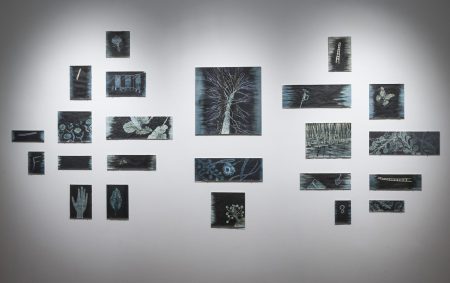
Photo courtesy of the Weston Gallery and Tony Walsh
Kern’s work consist primarily of drawings that are underpinned by a language of visual symbols developed over several years. These symbols reappear across the bodies of work in this exhibition. Her lexicon, inspired by (but not bound to) the natural world, includes ladders, houses, a moth with a pattern of eyes on its wings, leaves, plant forms, cells, hands, projectors, stars, undersea forms, “hairy headed plants”, trees, reflections, flowers, and looping “worm/necklaces”. In the collection of drawings, “The Future’s Not Ours”, she spotlights several of these main characters with a large grouping of small works in ink and pencil. The object-portraits are rendered floating in a black ground within a spikey border of twilight blue that transforms the ordinary into the enigmatic by charging the objects with the nervous energy of a jagged edge.

Photos courtesy of the artist

Photos courtesy of the artist

Photos courtesy of the artist
The show’s signature work, “Calling” and what is presented as a companion in the same room, an animated film “The Night is Dark and the House is Dark”, physically immerse viewers into Kern’s world. Through a dark curtain, one enters a blue underwater-like space with large drawings of plant forms resembling seaweed, seedpods, and flowers adhered to the walls and floor, surrounding the viewer. There is pleasure in moving through the space, observing the whimsical details in the forms, at which point viewers also become performers in the installation. The scale of this work playfully positions them as another ingredient swimming in Kern’s primordial soup of imaginary seas.
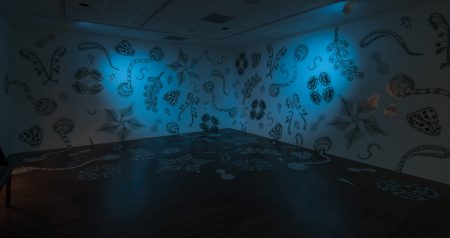
Photo courtesy of the Weston Gallery and Tony Walsh
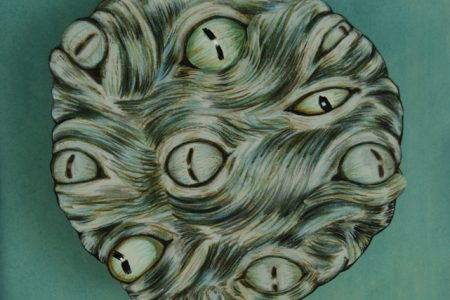
Photo courtesy of the artist
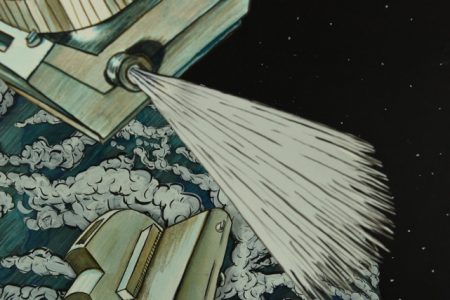
Photo courtesy of the artist
On the opposite wall, the film presents a simple narrative rendered in stop-motion animation techniques that convey the same sense of amiable eccentricity paired with subtle tension that characterizes many of Kern’s individual drawings. The darkness of woods gives way to the lonely, illuminated house. In the foyer, a sole moth (the one with the eyeball pattern on its wings) moves toward the light. Soon, a non-human form, like a cloud of feathers or fur with a hundred cat eyes, drifts into the room. This fantastic being is the sort of image that Kern is comfortable inventing and inserting into an otherwise familiar setting. It is funny and surprising, disarming the viewer of any preconceived notions of the rules of this environment. The feather-eye-cloud leads us beyond the window, where stars twinkle, and the viewer is ushered through dancing jelly-fish-like constellations into the vast depth of the night sky. We soon learn that the twinkling is from an unlikely source – the stars are actually old-fashioned slide projectors that circumnavigate the planet. These one-eyed creatures with probing light beams seem to be simultaneously projecting and seeking. Darkness becomes a space of curiosity and wonder, not of fear.
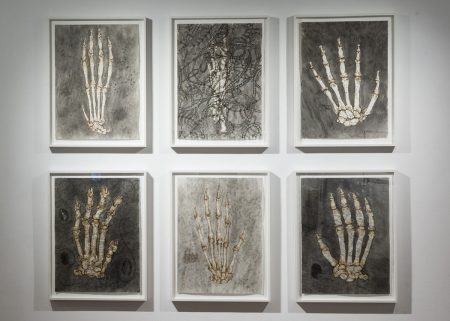
Photo courtesy of Weston Gallery and Tony Walsh
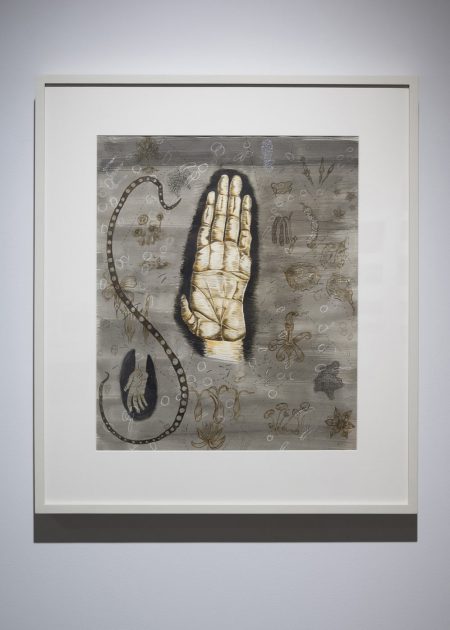
Photo courtesy of Weston Gallery and Tony Walsh
Kern explores another dimension of the relationship between earth and the heavens in her series “Soul Go Forth”. The title refers to the Catholic catechism used in last rites ceremonies that directs the departed soul to embark upon a journey that will unite it with Christ, professing the belief in life everlasting. The drawings’ individual titles reference a passage in the book of Romans that states nothing can come between God’s love and one’s soul. Yet, in this series of six drawings, Kern inserts science into these religious assertions. Skeletal hands of humans, gorillas, monkeys and other animals inhabit center stage of these works. The inclusion of the clawed lion and marmoset as well as hooved pig among the primates points to an evolutionary arc, this notion further enhanced by a pictorial space filled with cell-like forms. The gentle gesture of the outward facing palm, raised in friendship, peace, acknowledgement, blessing or warning, brings to mind not only the many readings of the hand signal across cultures, but also symbolism in art, specifically that of medieval Christian art. Three more primate-themed pieces, BLeaf Nature Study (orangutan), BLeaf Night Sky (chimpanzee), and BLeaf in Heaven (gibbon) indicate the tension inherent in questioning religious belief vis-a-vis faith traditions and scientific narratives. Opposable thumbs, paws, hooves, hands – these bones with history are evidence of evolution, but how does that intersect with faith? Further, with regard to ancient origin stories, what is meant symbolically and what is meant literally? These natural skeletal artifacts are suspended in ideology, as humans are suspended between cultural determinations of fact and fiction. Is eternity embedded in a mystical soul separate from the flesh or perhaps more metaphorically in the DNA that is passed down to from generation to generation?
The conceptual tension Kern illustrates is matched by the visual tension she establishes in her drawings. In much of this exhibition, her compositions consist of subjects drawn centered or floating in a visual field, not connected to anything, suspended, as in Calling, or disembodied, as in the Nothing in Fact or Fiction. They hover, not coming toward or moving away. They exist in a space with an illogical context, as in the The Night is Dark and the House is Dark: Slide Projectors in Space, or in a nebulous space, as in the Soul Go Forth series. With the exception of the film, the size of relative objects are exaggerated or diminished, confusing any sense of scale or perspective, suggesting a relationship among compositional elements that is more psychological than physiological.

Photo courtesy of Weston Gallery and Tony Walsh
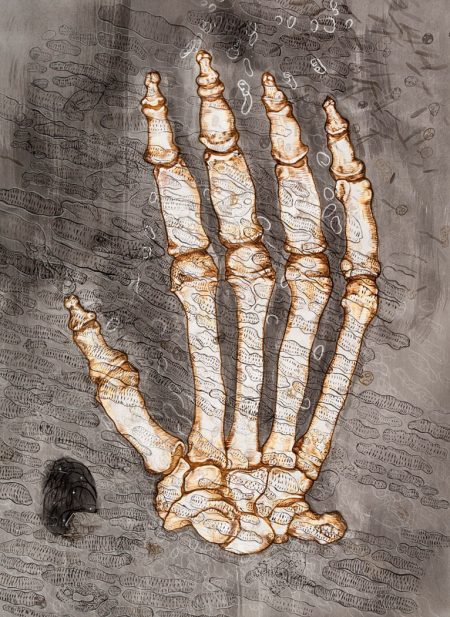
Photo courtesy of the artist
The ambiguity created by the unmooring of objects, be it silly, strange, or menacing, coaxes the viewer away from an expectation of realism, into an open-ended space of possibility, where ordinary rules of physics or logic need not apply. Kern does not always make this comfortable – she employs the awkward, sad, puzzling, anxious, or ominous with equal billing. Kern’s work combines childlike wonder and adult experience, blurring the lines between both, as she ponders big, real questions with close observation of a world of details, seen and unseen, felt, intuited.